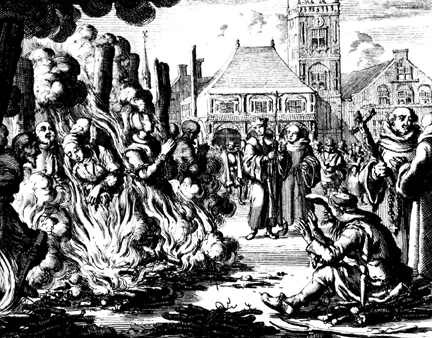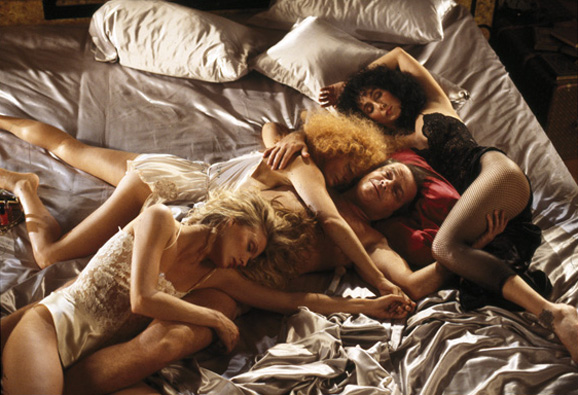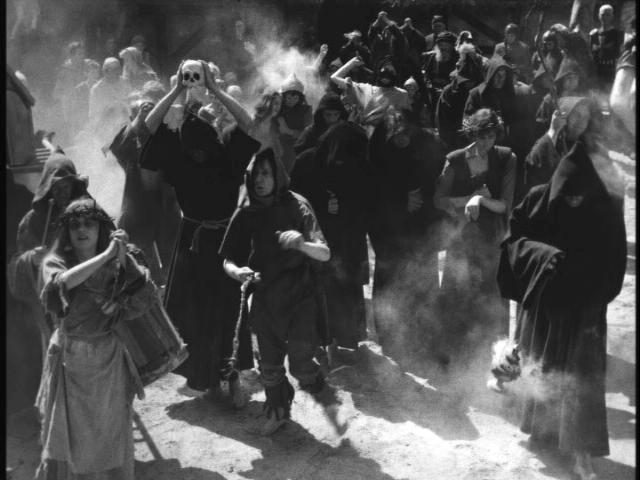Vampires of the Vanities, and bonfires of insanity. It was not the medieval world that produced the witchcraft delusion. Surprisingly, it was the age of the Renaissance and the Enlightenment. The dark ages were perhaps not all that dark after all. At least, with regard to witches, they could be quite sensible. To believe in witches or werewolves, said Saint Boniface in the eighth-century, was un-Christian. In the tenth century a church dignitary declared night flying a hallucination, and his declaration was accepted into the canon law. In the eleventh, the laws of King Coloman of Hungary refused to notice witches since they do not exist. However, the roots of paganism, as part of popular culture, went against the institutionalizing mission of the Church which bore the heavy and unappreciated burden as civilizing force among nations, and to which irritatingly, the light of the Gospel could not completely dispel.
The so called rubbish of paganism, and fecund collection of old wives tales; even the Devil of the middle ages had sank through familiarity into a form of contempt, now transformed into village hobgoblin, and banished with a magic formula. Calm water run deep, and the battle of the orthodoxy against the paranormal, the psychic and the inexplainable was not the lop-sized contest it was advertised at. Esoteric arts, the Egyptian Book of the Dead, Babylonian teachings, and other sources of spiritualistic tendencies retained a potency of belief.
The relative stability changed with the end of the Middle Ages. In the sixteenth century, the century of the Renaissance, and the seventeenth century, the century of the New Science, all Europe seemed given over to witches. Scotland and Hungary, where they had hitherto been unknown, were suddenly found to be swarming with them. By their own confession, thousands of old women every night anointed themselves with ”devil’s grease”, slipped through cracks and keyholes and up chimneys, and flew off to the witches’ Sabbath. As a pledge of their servitude they were constantly having sexual intercourse with the Devil, who appeared, since he abhors unnatural vice, to she witches as an incubus, and to he-witches as a succubus. The devil was an ecclesiastical gold mine for the Church since only the imagination could limit their own creative talents for imaginative fiction bordering on the absurd.
On the whole, the holy Mother Church followed the magisterial ruling of the angelic doctor, Saint Thomas Aquinas. The Devil, she ruled, could only discharge as incubus what he had previously absorbed as succubus; he therefore nimbly alternated between these postures. It seems surprising that the Roman Church, which has never renounced these beliefs, should not have recalled them to prove the diabolical nature of artificial insemination donors.
What was the Church to do when faced with this alarming epidemic of witches? In a geste of unrestrained compassion, it was to embark on a crusade of discovery, test and destruction. Given the absence of reliable, and irrefutable evidence such as pots full of human limbs, the effort was oriented towards the subjective and circumstantial where the harvest was likely to produce a better yield. It was certainly a good pre-text to clean out the old, the ugly and the smelly as well as others who gave hints of possessing certain aspects such as moles, warts and those involved in suspect professions such as mid-wives who were often ordered by the Devil to destroy newborn infants.
After step one, identification turned into confession. Witchcraft being a serious crime, there was no limit to the torture, which created an industry for implements and service professionals skilled in their use. The witches were expected, of course, to name all those neighbors and kinsfolk whom she had seen at the Sabbath. Even without torture, there were many self-accusing exhibitionists who were only too glad to give this special evidence. In this way whole villages were decimated, and even judges sometimes took fright at the ever expanding complicity. To be a witch and deny it, and deny it even under torture, was evidence of the blackest guilt. Such courage, it was agreed, could only proceed from hardened wickedness and the help of the Devil. In any case, whether she confessed or not, the witch was sent to the flames, unless, as a special grace from the Bishop or abbot or secualr lord, she was merely torn with red hot pincers and beheaded.
In England, it is fair to add, the methods were milder. Though the distinction could sometimes be blurred, there was no torture in English common law. The condemned witches were hanged not burned. Still, how could such lunacy have possessed humanity for almost two centuries? It seems inconceivable, and yet, though the numbers have been greatly exaggerated, the facts are not in doubt. It has even been termed as a form of gendercide against women.
There can be no doubt that the witch craze was organized and received its final organization late in the fifteenth century, by the medieval Church. The Church had equated witchcraft with the more serious crimes of sorcery and heresy resulting in a condemnation of those hitherto disregarded superstitions and hallucinations that spring, at bottom, from rural poverty. It is quite clear, as a systematic cult, was not discovered, it was invented by inquisitors. It was the inquisitors who discovered the first witches in Hungary and Scotland and who spread the epidemic over Germany. It was a classci problem, reaction, solution chain of events designed to increase power and resulted in tales of grand delusion destined to run a fabulous course. The disease was created by its pretended remedy. It was monkish phantasmagoria proposing credulities ; barbarous folly in the service of divine theology.
Italian scientist Girolomo Cardano, in 1550, said witchcraft was merely an illusion of minds distorted by poverty and undernourishment, and confessions were therefore worthless.But against massive, systematic propaganda, and backed by Pope Innocent VIII who trotted out the ”Witch-Bull, it was difficult to hold out. Clerical machinery was organized and lay intelligence was not. Moreover, the clergy controlled education. The sheer weight of documented rubbish ultimately overwhelmed most rational minds. There was a general sacrifice of the intellect made easier by that other phenomenon, the treason of the intellectuals. The Lutherans and Calvinists were equally caught up; in Geneva which had been free of witch trials saw Calvin introduce a reign of terror in which in the sixty years after his coming, one hundred and fifty witches were burned.











 COMMENTS
COMMENTS



